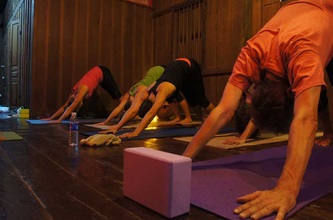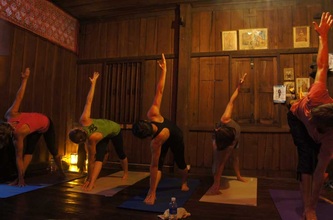 Jessica Magnin began her workshop last weekend by asking, “How many people made a new year’s resolution this year?” Out of a room full of 20 people, only four raised their hands. Then came the question, “For those who did not make one, why didn’t you?” The answer, for most, was simple. New year’s resolutions almost always fail. And there you have it, the word “FAIL” or “FAILURE.” Jessica explained that more often than not, the resolutions that we make are coupled with the potential to fail. Furthermore, resolutions such as “I will quit smoking this year” or “I will go to the gym four times a week” are created as a result of what we think we “should” be doing. A dictionary defines “should” as “used to indicate obligation, duty or correctness, typically when criticizing someone’s actions.” Thus in creating many of our resolutions, we’re engaging in a cycle of self-criticism, which leads to failure when the resolution is not fulfilled, which again leads to even more self-criticism.  What if we were to change the way we made our resolutions? According to Jessica, choosing the right words and the right intention is key. So let’s start at the top and instead of “creating a resolution” let’s call it “seeding our intentions.” Right there, we generate an image of new beginnings, of growth and of continuous change. We switch from what our brains think we “should” do to what our hearts feel we “want” to do. In choosing the words of your intention or Sankalpa, keep to larger and more general concepts such as happiness, peace or health rather than specific material desires such as money, career or body weight. Write down a few words or phrases, and then perhaps even a sentence using these words and phrases. When writing the sentence, be sure to begin the sentence with “I have” or “I am” rather than “I want” or “I must” so it becomes something positive that you are already experiencing.  It’s a simple process really, but the result is empowering. Repeat your Sankalpa to yourself three times and let it resonate from the depths of your heart. Feel it taking place already. Take this further by combining a yoga practice focused on back-bending to open the heart and the throat where anahata chakra and vishuddhi chakra are respectively located, manifesting thoughts and speech into reality. With the creation of the proper intention, seeded from the right words and right purpose, feel the connection to your true self or the nature of goodness within yourself that is unaffected by outside factors. Add twisting postures to your practice to illuminate your spine and remember, “the light within you is the same light that illuminates the entire universe.” Thank you Jessica for your teachings and thanks to all the participants who showed up to support the SMILE Project. Blog post by Julie (juliehana.com)
0 Comments
In December 2012 Al Jazeera producer and Huffington Post journalist, Bhanu Bhatnagar, completed his yoga teacher training and taught his first yoga class at the practice space in Ban Aphai. In line with the yoga community’s commitment to Karma Yoga, or service, the class was held as a fundraiser for the Traditional Arts and Ethnology Center (TAEC). Proceeds of the class that was held on December 10 went towards supporting TAEC’s mission of preserving cultural diversity in Laos.
Bhanu recently wrote about his first teaching experience in the Huffington Post. The article is a reflection on an experience that most yoga teachers can appreciate. For students, this is a great insight into some of the challenges that your teachers face as they strive to deliver guidance, knowledge and compassion in their classes. Read the Huffington Post article. The following photographs were taken by Casey Conroy. |
Archives
September 2023
Categories
All
|










 RSS Feed
RSS Feed
